Texas Flowering Trees (With Pictures) – Identification Guide
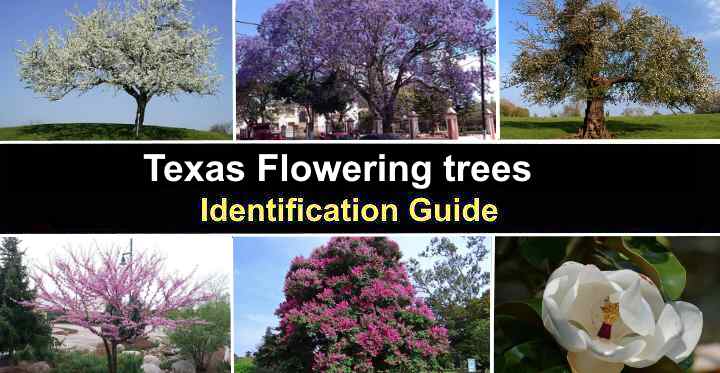
Flowering trees are a great way to add color and beauty to any landscape in Texas. Whether you’re looking for a small tree to fit into a tight space, or a large, showy shade tree, plenty of options are available to plant trees in Texas gardens. Flowering trees native to Texas are suited to the hot, dry, and sometimes humid climate in many parts of the state.
Native flowering trees in Texas include the Texas mountain laurel (Sophora secundiflora), Texas redbud (Cercis Canadensis var. texensis), desert willow (Chilopsis linearis), Texas sophora (Sophora affinis), and the Mexican plum (Prunus Mexicana).
Whatever the size of your front or backyard, there is a suitable flowering tree that thrives in the Lone Star State. Planting these flowering trees will fill your yard with white, yellow, pink, red, and purple blossoms in spring and summer.
This guide will help you identify some of the most popular flowering trees to grow in a Texas garden landscape.
What Are Flowering Trees?
Flowering trees are highly valued for their beautiful pink, purple, yellow, red, and white blooms. Many flowering trees blossom in spring in warm climates with sweet-smelling, showy, colorful flowers. In Texas, evergreen flowering trees retain their lush foliage, offering shade throughout the year.
Growing Zones For Flowering Trees in Texas
The key to successfully growing flowering trees in a Texan residential landscape is to choose the trees according to your growing zone. These zones help you know which trees will survive winter temperatures, which can dip below freezing in North Texas and the Panhandle.
Here is a short guide to USDA cold hardiness zones in Texas:
USDA Zone 6: The northernmost region of Texas — the Panhandle. Average minimum temperatures are -10°F to 0°F.
USDA Zone 7: Texas’s northern and central region from south of the Red River to Dallas-Fort Worth and Midland. Average minimum temperatures range from 0°F to 10°F.
USDA Zone 8: Most of Central Texas south of Dallas, El Paso, and San Angelo to San Antonio. Average minimum temperatures range from 10°F to 20°F.
USDA Zone 9: All Southern Texas south of San Antonio to the Mexican border and along the Gulf Coast.
How to Choose Flowering Trees in Texas
Apart from the USDA growing zone, choosing the best flowering trees for your Texas garden requires taking into account a few factors. For example, you should consider the amount of sun exposure, soil type, and mature size of the tree. It is also a good idea to choose from the native Texas trees as they are easier to maintain.
It is also good to consider the average annual rainfall of your area and its proximity to the coast. Many native Texas trees are tolerant of drought and salt air and are ideal for planting in coastal locations.
Flowering Trees in Texas (with Pictures) – Identification
Texas is home to a wide variety of flowering trees, each with unique characteristics. From the Texas Mountain Laurel to the Mexican Plum, there are plenty of options for adding color and beauty to your landscape.
Let’s look in detail at some of the best flowering trees for Texas landscapes.
Texas Mountain Laurel (Sophora secundiflora)
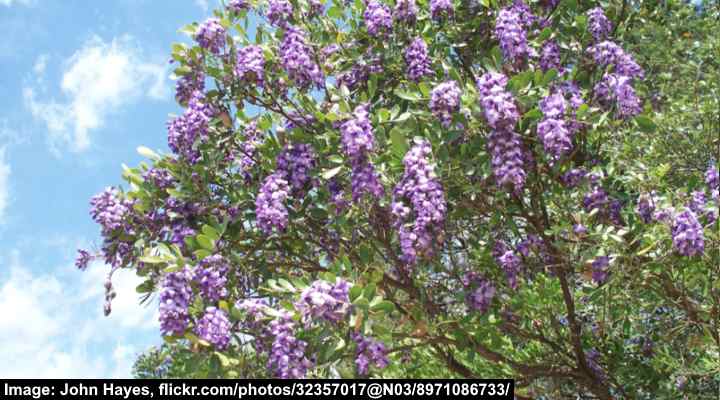
The Texas mountain laurel is a purple flowering tree native to Texas that is suitable for full sun or partial shade
Texas mountain laurel is a purple-flowering large shrub or small to medium-sized tree native to Texas. The small ornamental tree has clusters of fragrant purple flowers dangling from branches. The evergreen foliage consists of leathery, dark-green leaves that keep their color throughout the year. In the fall, long fuzzy gray seed pods decorate the shrub-like tree.
Texas mountain laurel is suitable for growing in full sun or partial shade throughout the Lone Star State. The flowering tree grows 15 to 25 ft. (4.5 – 7.5 m) tall and up to 10 ft. (3 m) wide. This decorative tree is tolerant of drought and heat and is ideal for xeriscape gardens.
Related reading: Types of Texas shrubs.
Purple Flowering Chaste Tree (Vitex agnus-castus)

The purple flowering chaste tree is well suited to be grown in Texas landscaped gardens
The chaste tree is a shrub-like tree with spectacular sprays of purple flowers measuring 12” (30 cm) long. The blue-violet blossoms are on show from summer through fall. Additionally, the small ornamental tree has gray-green palmate leaves with five to seven leaflets that produce silvery displays when they flicker in the wind.
The chaste tree isn’t native to Texas. However, it is well suited to growing in hot, humid landscapes and is highly drought-tolerant. It has a beautiful vase-shaped habit and grows 4 to 15 ft. (1.2 – 4.5 m) tall and wide. You can plant this small tree as a specimen plant, a patio tree, or along a property line.
Blue Jacaranda (Jacaranda mimosifolia)
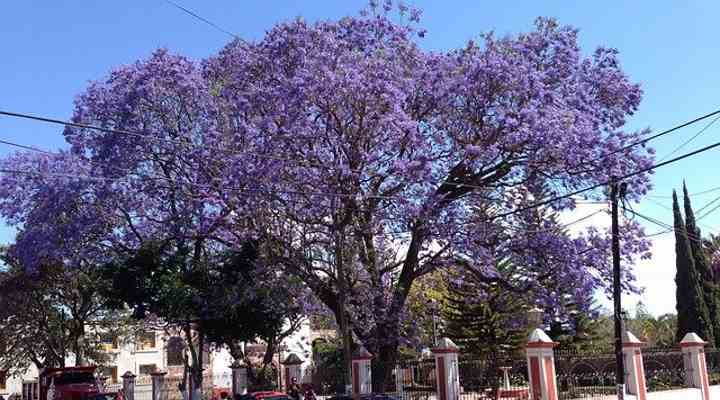
Jacaranda tree has beautiful purple flowers and can be grown in the southernmost part of Texas
The blue jacaranda is one of the most stunning purple-flowering trees you will find in Texas. In spring and early summer, masses of conical purple flower clusters cover the tree’s rounded, spreading crown. In addition, the tree has densely-growing long bi-pinnately compound leaves, making it ideal for shade. After flowering, woody seed pods appear on the tree.
The impressive shade tree grows up to 66 ft. (20 m) tall and 30 ft. (10 m) wide. Unfortunately, the jacaranda tree only grows in the southernmost tip of Texas due to its cold intolerance.
Desert Willow (Chilopsis linearis)
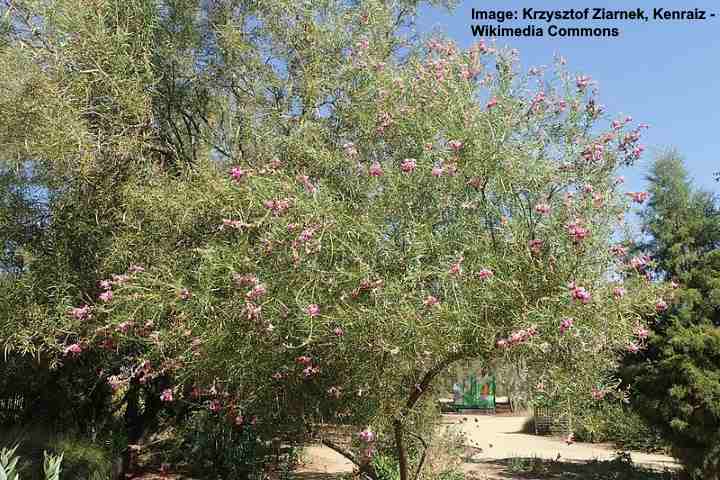
Desert willow is a small pink flowering tree native to Western Texas. In this picture: Chilopsis linearis ‘Timeless Beauty’
Desert willow is native to Western Texas and is a small deciduous tree with pink trumpet-shaped flowers. The identifying features of this desert tree are linear willow-like green leaves, showy clusters of pink flowers, twisted branches, and exfoliating bark. The tree also has an attractive silhouette giving it visual appeal in the winter.
Desert willow is suitable for growing in full sun and sandy, dry soils. The Texas tree grows 15 to 30 ft. (4 – 6 m) tall and 10 to 20 ft. (3 – 6 m) wide. The tree has rapid growth until it gets established in the landscape.
Crape Myrtle (Lagerstroemia)
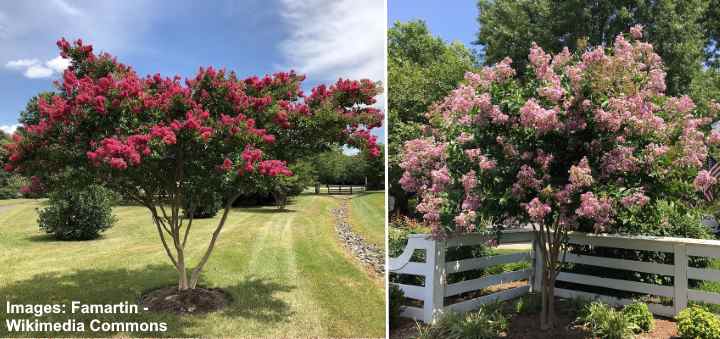
Crape myrtles are small flowering trees that grow best in full sun and are suitable for compact spaces
Crape myrtle is a group of small flowering trees or large shrubs beautifying southern landscapes. The outstanding ornamental feature of the trees is the large clusters of white, red, pink, or purple flowers. The tree blooms throughout the summer, filling Texas gardens with brilliant floral displays. The lush dark green leaves turn red and orange in the fall.
Depending on your landscaping requirements, you can grow crape myrtle as a desert shrub or tree. The flowering tree grows 8 to 15 ft. (2.4 – 4.5 m) tall and 6 to 10 ft. (1.8 – 3 m) wide. Thriving in full sun, the small tree is ideal as an informal flowering hedge or specimen tree.
Related reading: Crape myrtle bushes and shrubs.
Texas Redbud (Cercis canadensis var. texensis)
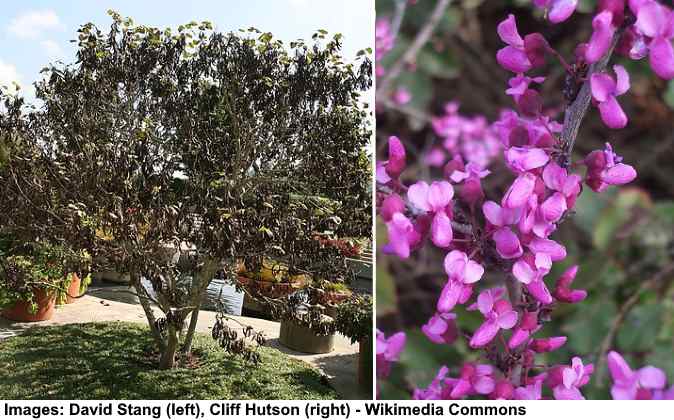
Texas redbud is a native small flowering tree with magenta colored decorative flowers
Texas redbud is a small native flowering tree that graces Texan landscapes. Redbud trees are known for their spectacular floral displays in early spring. This redbud variety ‘texensis’ has abundant pea-like pink or deep rose-red flowers covering bare stems. Its glossy green leaves turn golden yellow in the fall.
The showy flowers on this native Texas tree brighten spring landscapes throughout the state — from Amarillo in the north to Dallas and Galveston Bay. However, this decorative landscaping redbud thrives in hot and humid Texan summers. The Texan redbud grows 20 to 30 ft. (6 – 9 m) tall and 15 to 25 ft. (4.5 – 7.6 m) wide.
Texas Huisache / Sweet Acacia (Vachellia farnesiana)
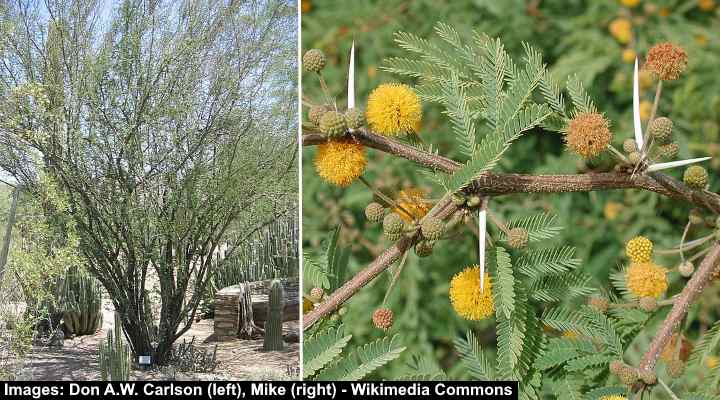
Texas huisache (sweet acacia) is a yellow flowering small tree suitable for Central and Southern Texas
Texas huisache is a multi-trunked tree with spiny branches, yellow flowers, and bipinnately compound leaves. This attractive summer-flowering Texas tree’s blooms are small, aromatic, bright yellow globose flowers. Its leaves look like those on a mimosa tree. After flowering, the tree produces dark reddish-brown woody seed pods.
Also called sweet acacia and perfume acacia, the Texas huisache emits sweet fragrances when in bloom. The small decorative tree grows 15 to 20 ft. (4.5 – 6 m) tall and wide. The yellow-flowering tree thrives in Central and Southern Texas. However, late frosts may destroy flower buds in northern regions of Texas.
Texas Sophora /Eve’s Necklace (Sophora affinis)
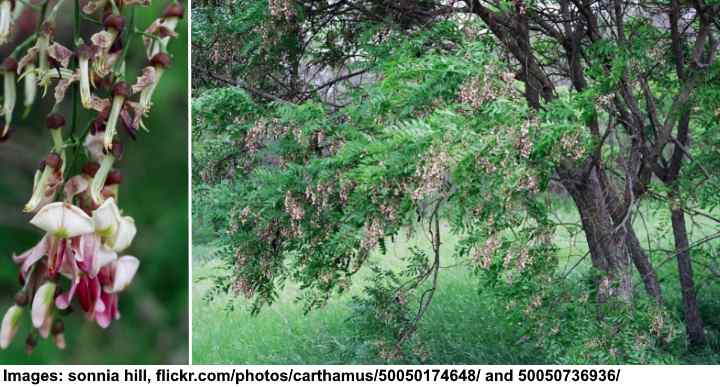
Texas sophora is a small to medium sized pink flowering tree which is suitable for most parts of Texas
Texas sophora is a small ornamental evergreen tree with dainty rosy-pink flowers emerging in spring. The clusters of dangling flowers contrast nicely with dark-green, lush leaves that form a rounded crown of dense foliage. After flowering, seed pods that look like a string of black beads appear.
Also called the necklace tree or pink sophora, this native Texas tree thrives in partial shade or full sun. The tree is drought-tolerant and withstands heat and humidity in USDA zones 7 to 9. The small tree grows 15 – 35 ft. (4.5 – 10.6 m) tall and 10 – 20 ft. (3 – 6 m) wide, and is commonly used as a specimen tree or understory tree.
Jerusalem Thorn / Mexican Palo-Verde (Parkinsonia Aculeata)
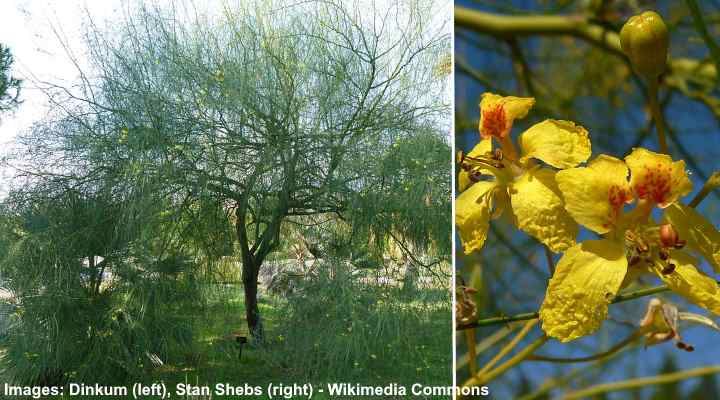
The yellow flowering Jerusalem thorn (Mexican palo-verde) is a small tree native to Southern Texas
The Jerusalem thorn is a yellow-flowering tree native to Southern Texas. This spectacular landscaping tree has golden-yellow funnel-shaped flowers with papery petals, unusual green bark, and small bright green leaves growing on arching stems. The small tree has an open, spreading crown creating dappled shade in southern gardens.
Also called Mexican palo-verde, the Jerusalem thorn tree has a four-season interest. Spring and summer have beautiful sprays of yellow blossoms. Then when the leaves drop in the dry season, the spiny green branches provide visual interest in the fall and winter. The small, fast-growing tree is ideal as a specimen tree or hedge.
The Jerusalem thorn tree grows 15 to 20 ft. (4.5 – 6 m) tall and 20 to 25 ft. (6 – 7.5 m) wide.
Mexican Plum (Prunus Mexicana)
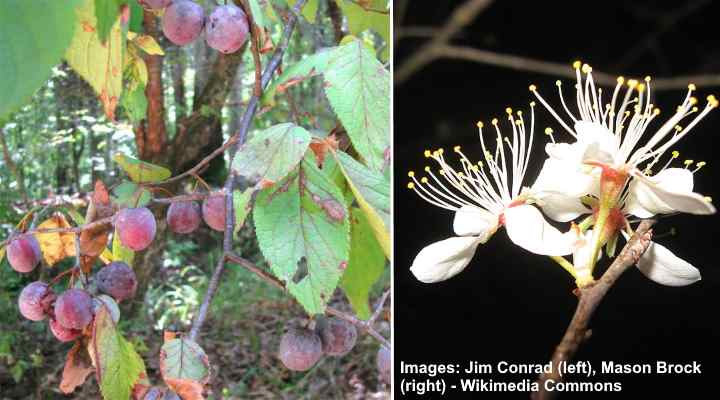
The Mexican plum tree can be grown in most parts of Texas and produces edible fruits and attractive white flowers
The Mexican plum tree is a small flowering fruit tree that explodes into rosy-white colors in spring. The native Texas tree has showy clusters of white flowers that bloom before leaves appear. The tree’s foliage consists of elliptic leaves with doubly-serrated margins. After flowering, purple edible plums appear on the tree and ripen by early fall.
As an interesting landscape tree, the Mexican plum grows 15 to 25 ft. (4.5 – 7.5 m) tall and wide. It’s cold-hardy in USDA zones 6 to 9 and thrives in full sun or part shade.
Related reading: Dwarf fruit trees for compact gardens.
Southern Magnolia (Magnolia grandiflora)
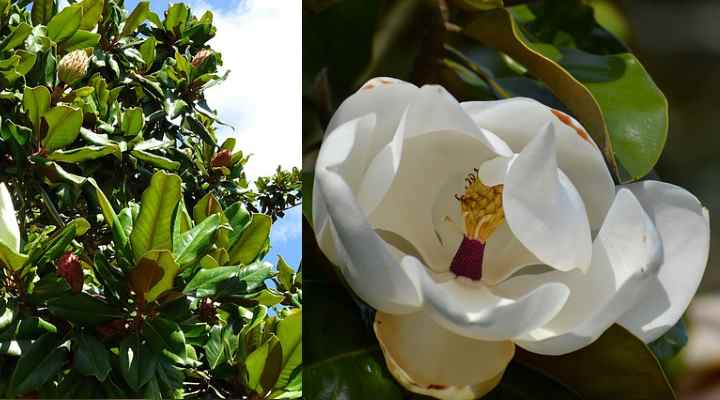
Southern magnolia is an evergreen white flowering large tree that is suitable for most parts of Texas except for the northernmost part
The southern magnolia is a large evergreen tree of the southeastern United States. This stately flowering tree has spectacular creamy-white, cup-shaped flowers measuring 8” (20 cm) across. The evergreen foliage consists of leathery, oblong leaves 5” to 10” (12 to 25 cm). The magnolia tree also produces brownish cone-like seed pods.
The southern magnolia tree can reach heights of between 60 and 80 ft. (18 – 24 m) tall and up to 50 ft. (15 m) wide, making it ideal as a shade tree in a Texas landscape. You can plant the native tree throughout Texas, apart from the Panhandle.
If the impressive southern magnolia tree is too large for a compact garden, you can consider a dwarf evergreen magnolia. For example, the Magnolia grandiflora ‘Little Gem’ has evergreen leaves and stunning white flowers. And it only grows 15 to 20 ft. (4.5 – 6 m) tall and 10 ft. (3 m) wide.
Two-Wing Silver Bell (Halesia diptera)
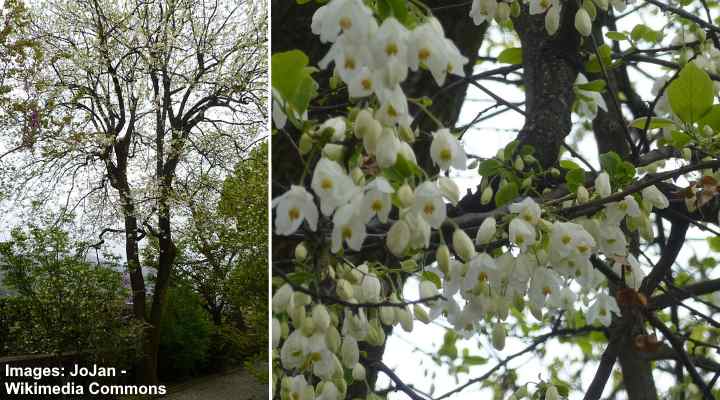
Two-wing silver bell is a native white flowering tree suitable for Northern and Central Texas
One of the most stunning white-flowering native Texas trees is the two-wing silver bell. The attractive ornamental small tree has clusters of pendulous white flowers blooming in early spring. The tree’s foliage consists of 6” (15 cm) long green oval leaves. These turn yellow in the fall before they drop.
Growing 20 to 30 ft. (6 – 9 m) tall, the two-wing silver bell tree thrives in full sun and moist, organically-rich well-drained soil. The decorative landscape tree is ideal as a specimen plant or shrub border.
Suitable for USDA zones 5 to 8, the tree won’t tolerate the intense heat and dry soil of Southern Texas. It also doesn’t grow well in coastal regions.
Callery Pear (Pyrus calleryana)
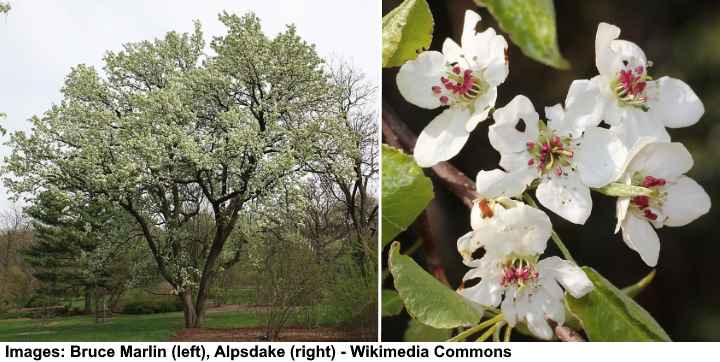
Callery pear is an ornamental flowering pear tree with spectacular white flowers every spring
The Callery pear tree is a fast-growing deciduous flowering tree for Texas gardens. The medium-sized tree blooms profusely in early spring with abundant clusters of five-petaled white flowers. Its leaves are glossy, dark-green, covering the upward-growing branches that form a pyramidal crown. Its fall color is orange, red, and dark maroon.
The Callery pear is sometimes called ornate fruitless pear tree. Although it actually produces fruit, the tiny pears on ornamental pear trees are too insignificant to be useful.
The Callery pear grows 30 to 50 ft. (9 – 15 m) tall and up to 35 ft. (8 m) wide.
Goldenball Leadtree (Leucaena retusa)
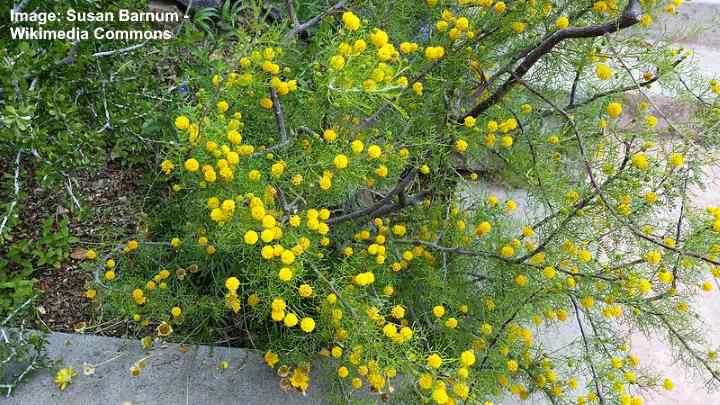
The yellow flowering goldenball leadtree is heat and dry tolerant and native to West Texas
Goldenball leadtree is a slow-growing deciduous flowering tree native to dry regions in west Texas. The outstanding landscape feature of the ornamental tree is its fuzzy golden-yellow puffball flowers. In addition, attractive bi-pinnately compound leaves, 10-inch (25 cm) brown seed pods, and reddish-cinnamon flaky bark adorn this decorative tree.
Goldenball leadtree thrives in full sun and well-drained soils in USDA zones 7 to 11. It grows up to 25 ft. (7.5 m) tall and wide and has high heat tolerance.
Texas Madrone (Arbutus texana)
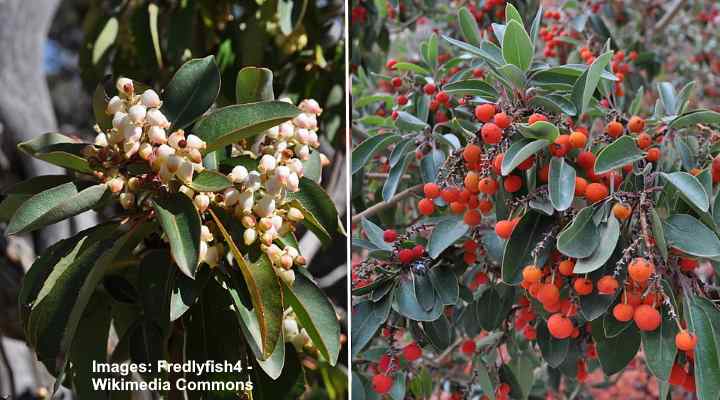
The Texas madrone ornamental tree has white flowers and red or orange berries and is suitable for Central Texas
Texas madrone is a small evergreen tree that thrives in Central Texas. The ornamental features of the small tree are its small white flowers blooming in spring, dark green oval leaves, peeling bark, and brightly-colored red or orange berries. The native tree grows 25 to 40 ft. (7.5 – 12 m) tall and up to 25 ft. (7.5 m) wide.
Landscape uses for the Texas madrone include a lawn tree, deck or patio tree, or planted in a row to form an informal flowering hedge. The small ornamental tree grows well in a patio container.
Texas Hawthorn (Crataegus texana)
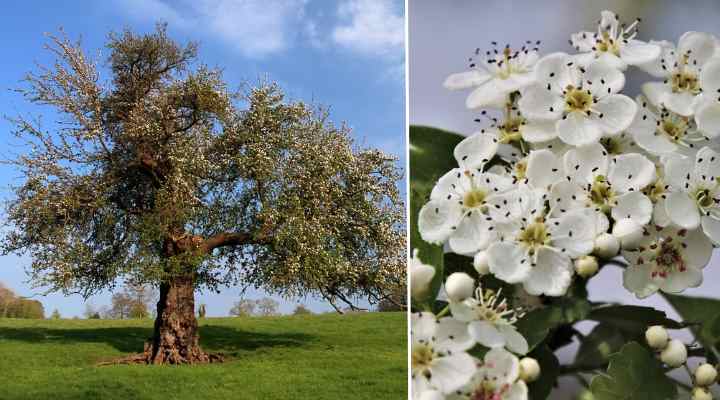
Texas hawthorn is a native flowering deciduous tree with small red fruits and white flowers
Hawthorn is a group of small shrub-like thorny trees with white, disc-shaped flowers. The species Crataegus texana is native to the Lone Star State. The flowering Texas hawthorn has lance-shaped leaves with serrated margins. After flowering, small red berry-like pomes measuring 1” (2.5 cm) ripen on the tree.
Thriving in sunny climates, the Texas hawthorn thrives in marshy areas in the Rio Grande Plains and Gulf Prairies. It also performs well in coastal regions along the south-central area of Texas. The small tree grows 20 to 25 ft. (6 – 7.5 m) tall and wide.
Fringe Tree (Chionanthus virginicus)

The small deciduous fringe tree has white scented flowers and can be grown in all parts of Texas
The fringe tree is a flowering tree native to the Eastern United States. Its outstanding decorative feature is its drooping clusters of creamy-white, fringe-like flowers. With its spreading, rounded habit, this small tree has lanceolate leaves that are 8” (20 cm) long and turn golden yellow in the fall.
After the spring flowers have finished, the fringe tree produces dark, bluish-black olive-like fruits that ripen by late summer.
The fringe tree is suitable for all growing zones in USDA zones 3 to 9. The tree thrives in moist soil and grows in its native habitat along street banks and rocky ledges. The fringe tree grows 12 to 20 ft. (3.6 – 6 m) tall and wide.
Related articles:
